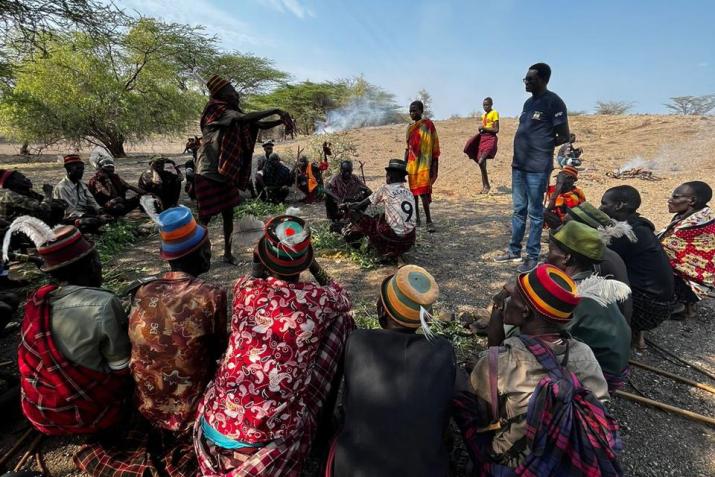
Elders from a pastoralist community in Kenya’s Turkana County meet with David Ekai (standing, right), the county’s coordinator for malaria prevention. Because pastoralist communities are often remote, pastoralists may have to walk for miles to reach a healthcare facility if they become sick. (Photo by Joseph Kipkoech)
Published June 9, 2025, last updated on June 14, 2025 under Research News
For the pastoralist communities that live in the arid rangelands of northern Kenya, life has never been easy. Men often walk for miles under punishing heat, shuttling herds of goats and cattle across the dusty plains in search of pasture. Women and children rise before the sun to collect water from deep holes along dry riverbeds. Periods of prolonged drought, which are frequent in one of the hottest and driest places on Earth, cause such struggle that they are given names to preserve their memory in oral history.
Despite its grueling physical demands, this semi-nomadic way of life has persisted for nearly 5,000 years. Archaeological finds in the region – including 1.5 million-year-old hominid footprints and some of the earliest evidence of stone tools – indicate that our ancestors thrived there even longer, making it one of the first places on Earth that humans learned to be human.
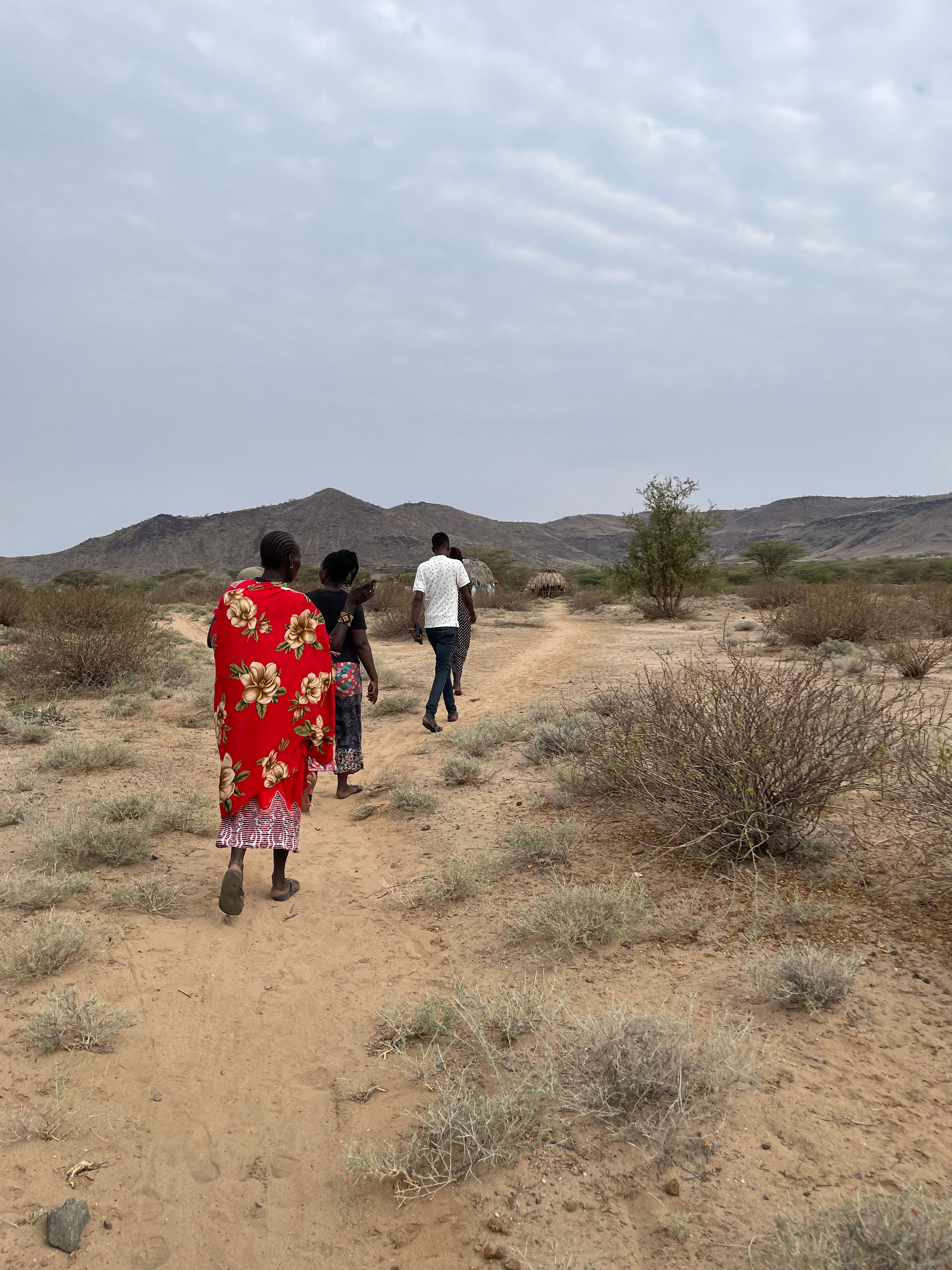
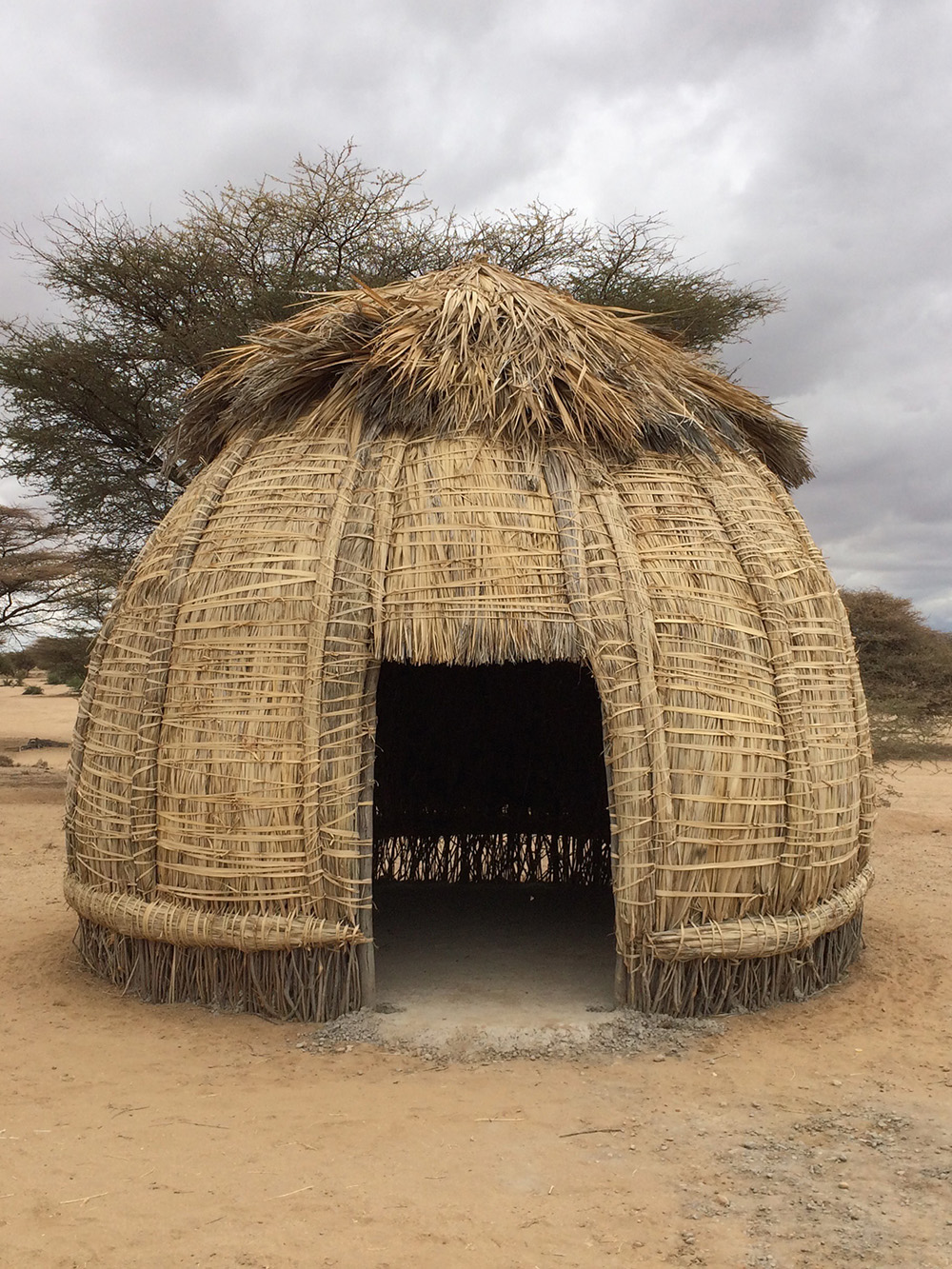
But as climate change exacerbates the region’s already extreme conditions – which feature daytime temperatures that often soar above 100 degrees Fahrenheit and months with little or no rainfall -- many pastoralists are reconsidering the sustainability of their traditional lifestyles. Over the past few decades, thousands of families have left the rangelands for permanent housing in fast-growing towns and trading posts to the east and west of Kenya’s Lake Turkana, where they have access to schools, healthcare centers, and shops selling food and essentials. A cycle of brutal droughts has accelerated the transition, most notably an 18-month dry period in 2021 and 2022 that killed more than 1.5 million livestock and left an estimated 4.2 million Kenyans in need of food assistance, according to reports from the United Nations’ Office for the Coordination of Humanitarian Affairs.
It's a move that has been welcomed by many outside development groups, who worry the pastoralist lifestyle leaves its practitioners vulnerable to hunger and malnutrition, which are indeed widespread among pastoralist communities. But there’s a surprising caveat: The people settling in market villages aren’t faring much better than those who have maintained the pastoralist lifestyle. In fact, by some measures, they’re doing worse.
“It looks like people are generally less well when they are living in town,” says Herman Pontzer, Ph.D., a professor of evolutionary anthropology and global health at Duke who has been studying one pastoralist group, known as the Daasanach, since 2017. “And you might not expect that, because it seems like life is easier there.”
The Costs of Settling Down
In a series of studies, Pontzer and his team have found that Daasanach living in market-centered towns have higher blood pressure and cholesterol levels than those practicing pastoralism. They are also beginning to see more Daasanach people with elevated levels of C-reactive protein (CRP), a biomarker associated with chronic inflammation, which often signals the onset of cardiometabolic problems such as obesity or hypertension.
Chronic inflammation is more commonly seen in sedentary populations, where low levels of physical activity and overeating can lead to the body having more energy than it can burn. Excess energy gets channeled into the immune system, triggering an inflammatory response.
“In an energetically constrained environment, you allocate energy to all the important things first, and you run out before you can allocate it to your immune system,” says Anna Tavormina, a 2025 graduate of the Duke Master of Science in Global Health program who studied CRP levels in Daasanach communities for her thesis research. “In contexts where there are a lot of calories available, we think some of that excess energy is being routed to the immune system in a way that is not good for health.”
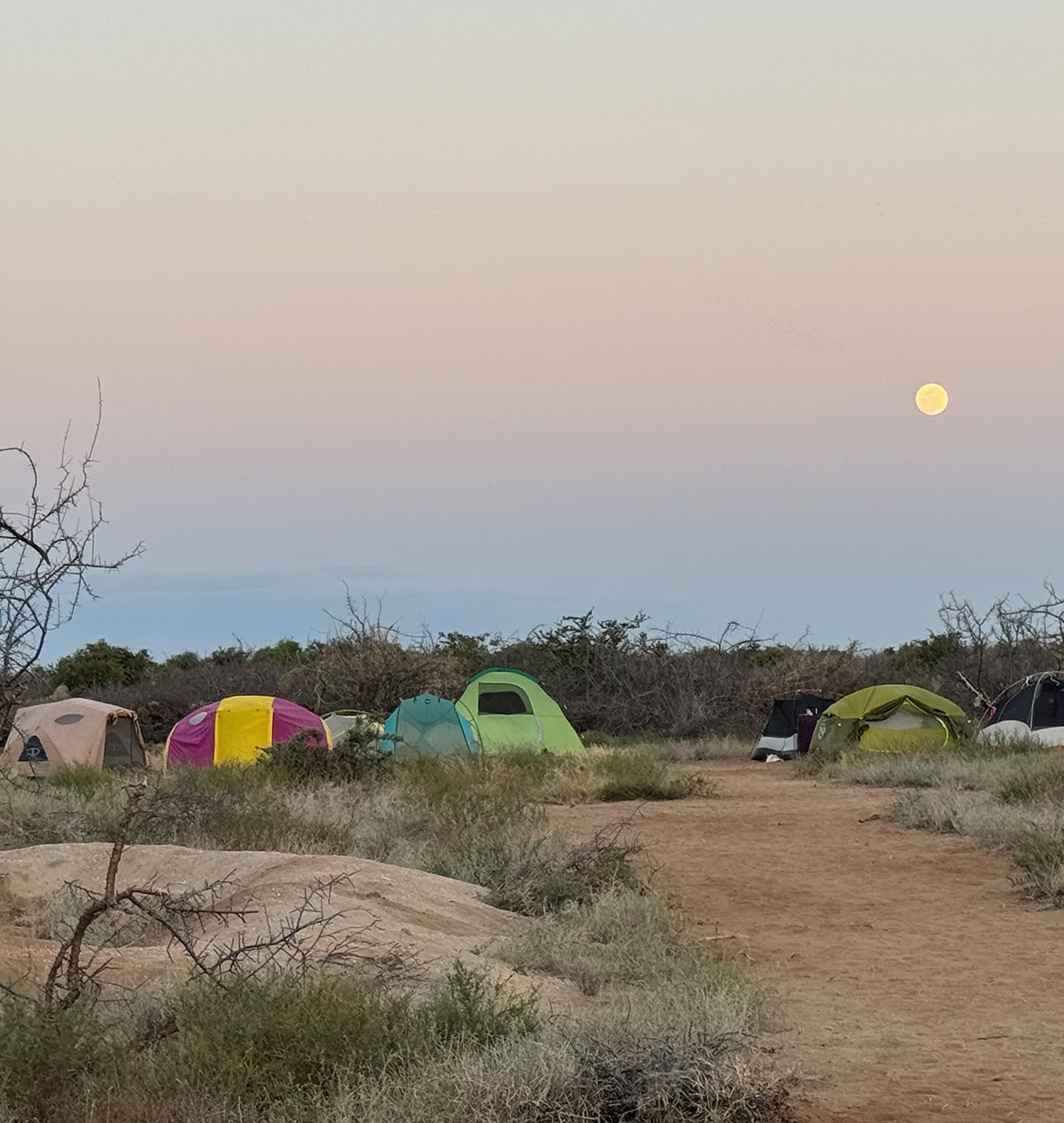

The findings add to other evidence that settling down isn’t making pastoralists any healthier. Last year, for example, a longitudinal study funded by the U.S. Agency for International Development concluded that the children of people leading sedentary lives in two counties in northern Kenya are more likely to be acutely malnourished than those of pastoralists. Chronic conditions such as diabetes, hypertension and cancer – once almost unheard of in the rangelands – now account for one third of hospital cases in Kenya’s Turkana County, according to a county official.
The incidence of such problems is still below what you’d find in most Western societies. But as an evolutionary biologist, Pontzer is concerned about the impact that market integration is having on a population that has spent millennia adapting to the intense physical demands of pastoralism.
“From an evolutionary perspective, these changes are happening really fast,” Pontzer says. “And so we want to understand how this shift to a less active lifestyle is impacting their health in real time.”
Collective Adaptations
The research also raises questions about the strategies outside groups have relied on in their efforts to help address malnutrition and hunger among pastoralist communities. Going back as far as the 1950s, a succession of governments and aid organizations have come to Kenya’s arid northern counties to provide food assistance and build permanent infrastructure such as wells and schools. But by encouraging settlement, those initiatives may have helped undermine some of pastoralists’ most effective strategies for dealing with the extremes of their environment.
“The way solutions have been prescribed to us, it has never placed the part of the pastoralists at the center,” says Gilchrist Lokoel, chief officer for livestock development in Turkana County, where around 80 percent of the county’s 1 million residents practice a form of pastoralism.
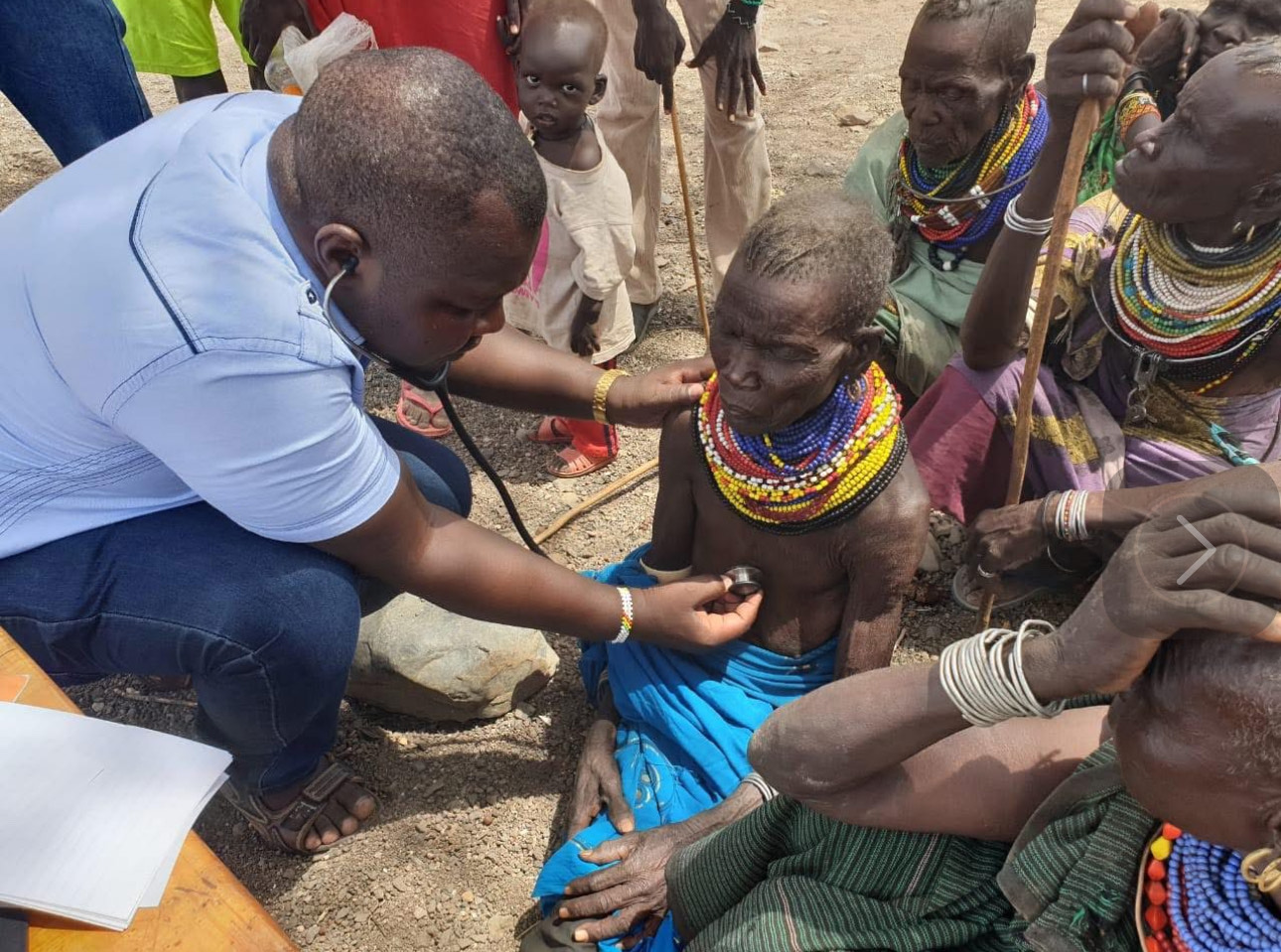
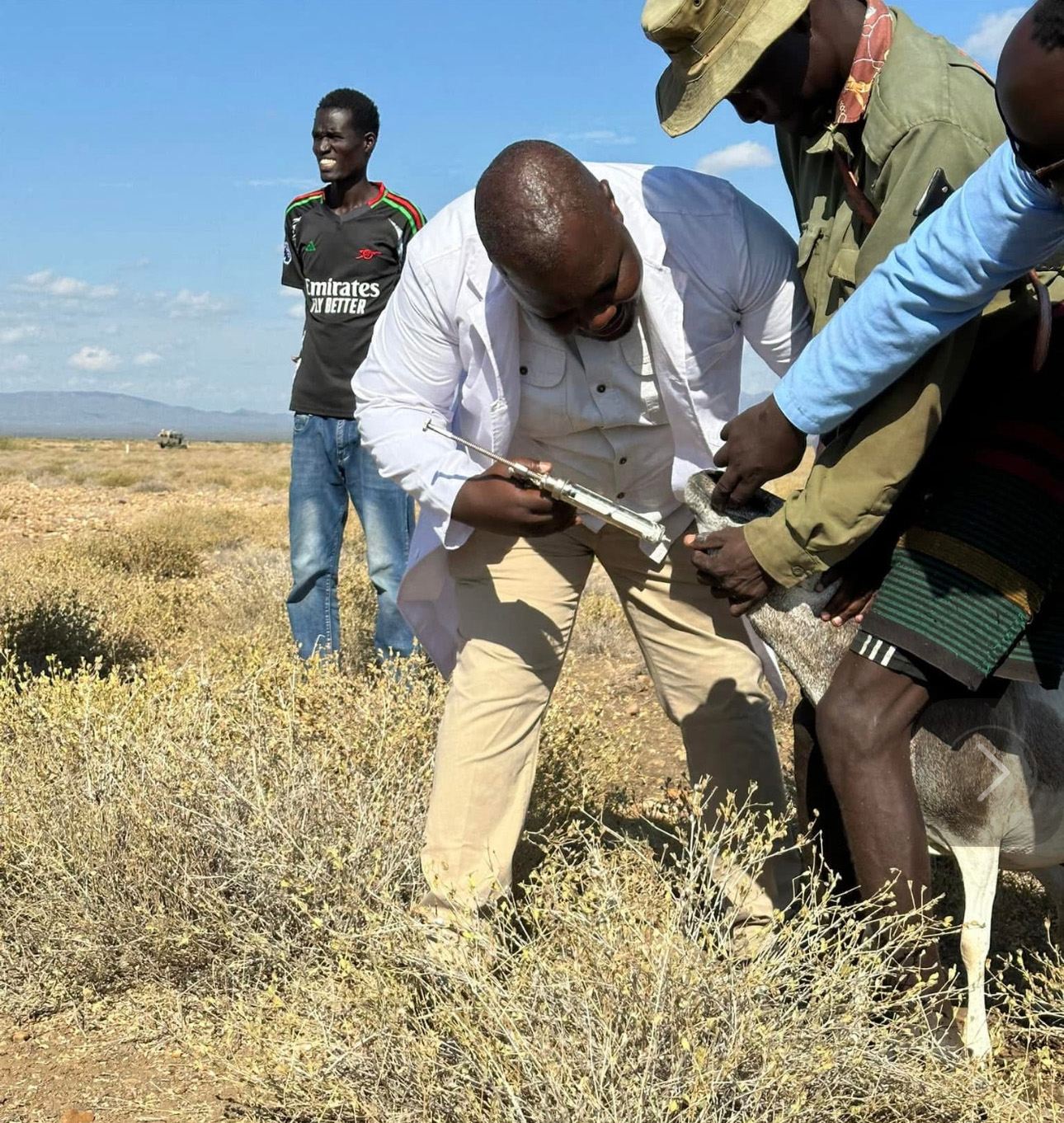
A medical doctor by training, Lokoel agrees that the region’s inhospitable climate poses risks for both animals and those who tend them. But he points out that pastoralists have many strategies to cope with prolonged periods of drought, including moving animals to areas with better vegetation and stockpiling dried meats to keep families fed during dry seasons. Community leaders often reallocate livestock to aid individuals whose animals have died, or who are struggling to find enough food, he notes.
“You have a social network that cushions you [from the effects of drought],” he says. “The individualism that comes with life in the town actually makes you more vulnerable.”
Cut off from those collective adaptations, people living in towns often rely on donations from food aid programs when resources are scarce. But the poor nutritional quality of food aid, which often includes large quantities of rice or maize flour, may be one of the factors worsening malnutrition among people in the towns. And as necessary as it may be in a crisis, food aid can also fuel a cycle of dependency: An analysis of emergency food relief programs following a 2011 drought, for example, found that many pastoralists grew reliant on the aid, eroding the cultural practices at the foundation of their centuries-long self-sufficiency.
“Prolonged food assistance is actually like an opium, which if not properly utilized and monitored can get you addicted,” Lokoel says.
Promoting Health Within Culture
Pastoralists are well aware of the fragility of their practices in a new climate reality, Lokoel says. And despite their long traditions, they aren’t opposed to change. They just want to see their perspectives included in it.
“There must be a dialogue,” he says. “You must show me for me to buy into your ideas.”
Through his role with the county, Lokoel is working to introduce breeds of goats and cattle that produce more milk and are better adapted to droughts. He’s also launched a project to help young farmers learn how to grow grasses, potentially reducing the need for pastoralists to travel long distances to find places for their animals to graze.
Fishing is also gaining in acceptance among some pastoralists, who have traditionally viewed people who fish as inferior in status to those who own livestock. During her field research with the Daasanach in summer 2024, Tavormina interviewed women who were learning to fish the waters of Lake Turkana as an alternate source of income for their families. “Even when their husbands are away [grazing animals], they can make sure there is money to put food on the table or send their kids to school,” she says. “It’s creating this new sense of independence for them.”
Another example of a more collaborative approach is an effort over the past few years to prevent malaria infections among children in Turkana, which required some unique adaptations to serve the county’s many nomadic populations. “The standard model for malaria prevention in Kenya, and in most of sub-Saharan Africa, is to give someone a [mosquito] net, and they’re supposed to sleep under that net every night to be protected from malaria,” says Wendy Prudhomme O’Meara, Ph.D., a professor of infectious diseases and global health at Duke and Kenya’s Moi University who led the project.
But O’Meara knew nets wouldn’t be practical for pastoralists, who travel across the landscape, carrying their belongings with them and typically sleeping in temporary, tent-like structures. Instead, her team developed a plan to find and reach the far-flung villages each month to deliver preventative doses of antimalarial drugs to children under five, a campaign that ultimately reduced seasonal cases of malaria by 70 percent during the study.
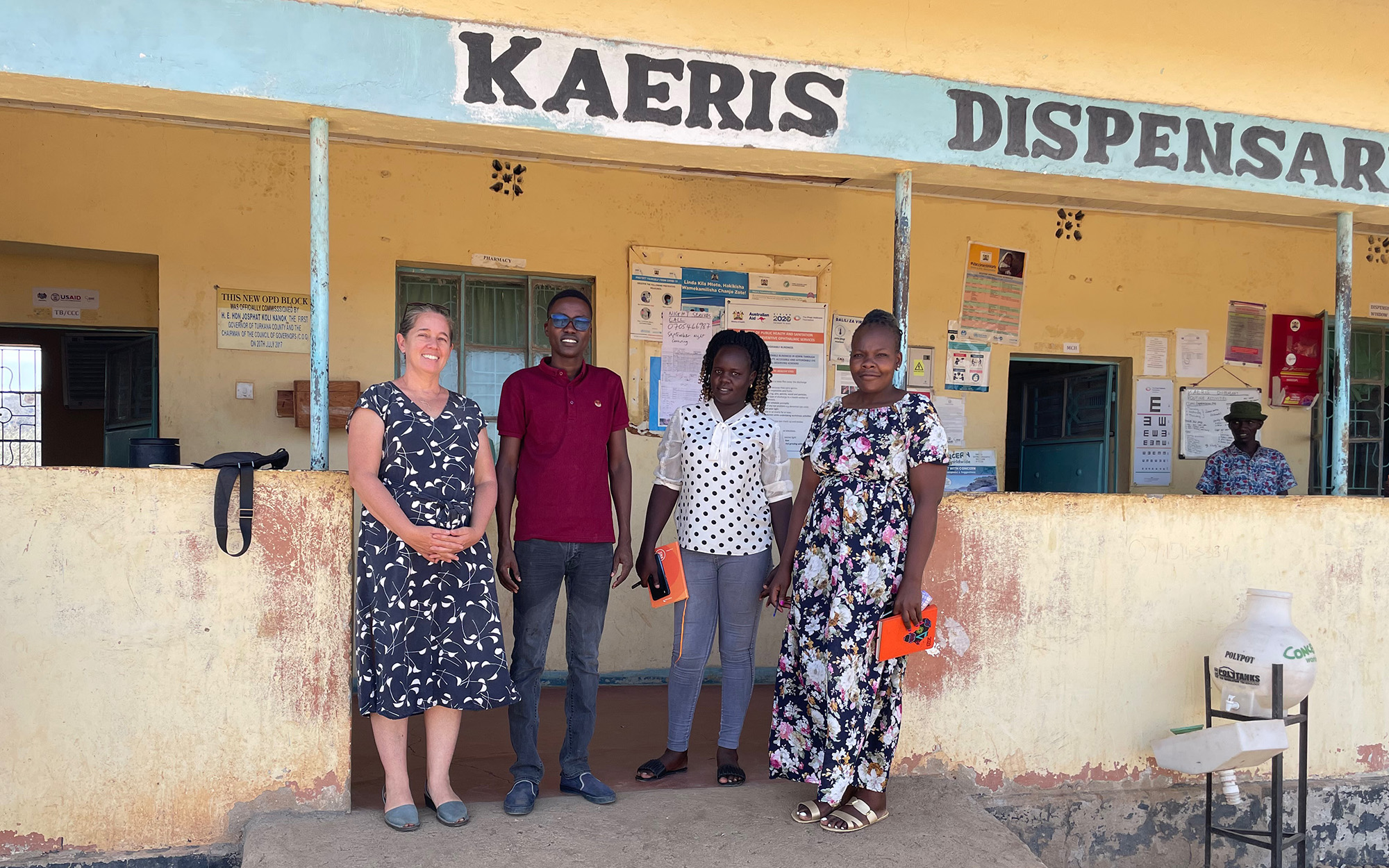
“We spent a lot of time talking to the communities about how we could reach them, and what would be the avenues they would trust,” says O’Meara, who notes that parents in pastoralist communities sometimes have to walk up to 15 miles to seek medical care for a child who is sick with malaria.
The goal, O’Meara says, was to create an intervention that works alongside pastoralist culture and practices, rather than forcing pastoralists to choose between their health and their traditions. It’s a deliberate departure from interventions of the past, regarding pastoralism not as a curiosity or historical artifact, but as a way of life with relevance for modern-day existence.
In his work with the Daasanach, who live on the opposite side of Lake Turkana from the communities where Lokoel and O’Meara collaborate, Pontzer is equally focused on the present. He says findings from his team’s studies of energy and metabolism can help pastoralists understand the impact of rapid changes to their lifestyle and environment. But the research may also help us learn why pastoralists have been so successful living in such harsh conditions – knowledge that could be critical to helping traditional and indigenous communities facing the brunt of climate impacts across the globe.
“People caricature these groups,” says Pontzer, who has also studied energy and metabolism among hunter-gatherer communities in Tanzania. “I think part of what we’re trying to do is to say that you don’t have to tell stories about them. They aren’t ancient history. They are still here, and we can still learn from them.”


